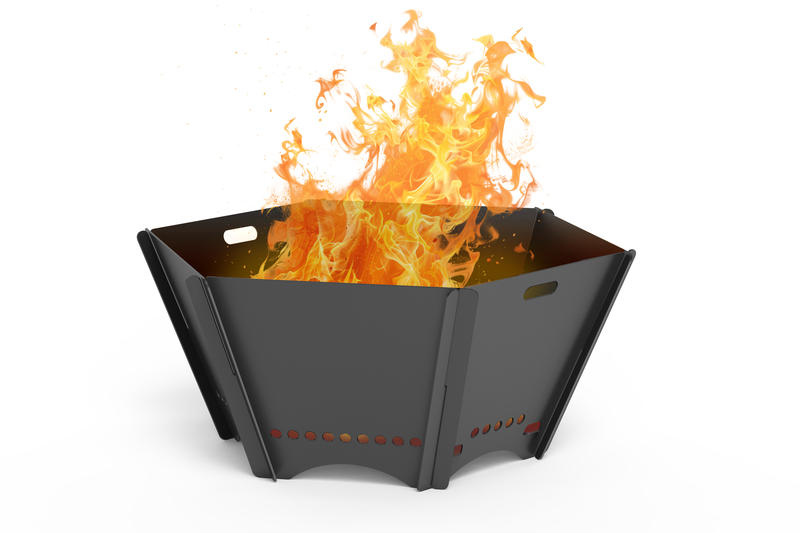
Using a Wood Burning Fire Pit
Introduction: The Importance of Site Selection
Before sparking that first flame, it's crucial to consider the site selection for your fire pit. The right location ensures you enjoy the warmth and ambiance while keeping safety in mind. From proximity to flammable materials to comfort and aesthetics, thoughtful site selection lays the groundwork for enjoyable and safe outdoor fires.
Site Selection: Choosing a Safe Location for Your Portable Fire Pit
When choosing a place for your portable wood-burning fire pit, ensure the area is free of buildings and low branches. Also, keep it away from anything that can catch fire. A minimum distance of 10 to 20 feet from your home, fences, and other structures is generally recommended. Also, check local rules. Some places have specific requirements for where to place fire pits. This is based on climate and fire risks.
Consider the wind direction as well. It's advisable to place your fire pit in a position where the wind will blow smoke away from seating areas. Furthermore, think about how the space will be used. Make sure your chosen site has enough space for seating. It should also allow easy access for everyone to enjoy the warmth without feeling crowded.
Finally, consider the aesthetic aspects. A beautifully placed fire pit can enhance the overall look of your backyard. Choose a location that complements your landscaping and allows for good visibility from your home and patio.
Maintenance Routine: Cleaning Tips, Rust Prevention, and Fuel Management
Maintaining your wood-burning fire pit is crucial for longevity and safety. After each use, allow your fire pit to cool completely before cleaning. Remove the ashes with a shovel or broom to prevent buildup, which can become a fire hazard or lead to rust formation over time.
For rust prevention, consider using a fire pit cover to protect it from rain and moisture when not in use. If your fire pit is made of metal, you might want to periodically check for signs of corrosion. Applying a rust-resistant paint or sealant can also help prolong its life and maintain its appearance.
Fuel management is a significant part of maintenance as well. Always use dry, seasoned wood to minimize smoke and creosote buildup in your fire pit. Store wood in a dry area, elevated off the ground to prevent moisture absorption. Think about using different types of wood for different burning experiences. Hardwoods like oak and maple burn longer and make less smoke than softer woods.
Tips on Starting a Wood Fire: Wood and Kindling Selection, Stacking the Wood, and Other Ideas
Starting a fire in your wood-burning fire pit can be an enjoyable process with the right approach. Begin by selecting quality wood and kindling. Avoid using treated or painted wood, as it can release harmful chemicals when burned. Instead, opt for dry kindling like twigs or small pieces of wood to kickstart your fire.
When stacking your wood, use the classic teepee method: place a few pieces of wood in a teepee shape, leaving enough space for airflow at the center. Add your kindling in the center before lighting. This design ensures good airflow and helps the fire catch easily. Additionally, do not overload your fire pit; give your fire enough room to breathe for optimal burning.
Other tips include using fire starters, such as natural wax fire starters or newspaper, to help ignite the kindling. Always keep a bucket of water or a fire extinguisher nearby in case of emergencies.
Safety Protocols: Proper Use Guidelines, Fire Extinguishing Methods, and Emergency Tips
Safety is paramount when using a wood-burning fire pit. Always monitor the fire, never leaving it unattended. Teach children about fire safety and establish a safe zone around the fire pit. It’s essential to keep a safe distance from the pit and to ensure that any flammable materials are stored away from the area.
Proper extinguishing methods are also key. Allow the fire to burn down as much as possible before trying to extinguish it. Use water to douse the ashes entirely, ensuring cold embers and ash remain. Stir the ashes with a stick or metal poker while pouring water to help ensure all heat is gone. Never pour flammable liquids like gasoline on the fire.
In case of an emergency, be familiar with the basic protocols. Know how to contact emergency services in your area and keep a first aid kit handy. If someone gets burned, cool the area under running water for at least 20 minutes before seeking medical attention.
Read more at Tarter Home's fire pit guide or shop our portable fire pits here
